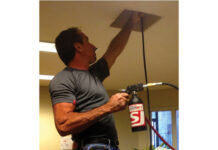The process of laying new carpet may seem like a straightforward task, but beneath the surface lies a realm of intricacies that can make or break the outcome.
Whether you’re embarking on a DIY carpet installation project or entrusting it to the hands of professionals, the key to success lies in meticulous preparation and adherence to fundamental principles.
In this guide, we delve into the art of carpet installation, unveiling the essential do’s and don’ts that will transform your flooring endeavour into a resounding triumph.
From precision measurements to subfloor perfection, the quality of padding, and the strategic planning of seams, every aspect demands attention. We’ll explore each facet in detail, equipping you with the knowledge and insights needed to achieve a seamless and long-lasting carpet installation that enhances both comfort and aesthetics in your living space.
So, let’s unroll the carpet of wisdom and embark on a journey towards flooring excellence.
Cut the old carpet into strips
By cutting the old carpet and underlay into strips, you’ll find it much easier to remove it from the home. You’ll also find it easier to lift and get down to the skip. If you plan on taking it in your car, then the smaller your car, the smaller width of the strips should be.
Don’t try to take the whole carpet out in one
As suggested above, if you want it to be easier to lift and handle, don’t try to roll up the whole room of carpet. Of course, if you’re going to reuse it then there might be an exception.
Take Accurate Measurements:
Begin by accurately measuring the room’s dimensions. Take into account any alcoves, irregularities, or recesses. This precision ensures you order the right amount of carpet, minimizing waste and ensuring a proper fit.
Never rush your measurements Measurements
Avoid rushing through the measurement process. Inaccurate measurements can lead to unnecessary expenses and material wastage. Take your time to get it right.
Invest your time in Subfloor Preparation
Prepare the subfloor meticulously. Remove all debris, nails, and old adhesives. Repair any imperfections like cracks or holes. A smooth, clean subfloor is essential for a level carpet installation.
Don’t neglect the Subfloor
Neglecting subfloor preparation can result in an uneven carpet surface, premature wear, and even potential damage to the carpet. Don’t skip this crucial step.
Use a high-quality Underlay for best-padding
Don’t compromise on carpet padding quality. Opt for a high-quality carpet underlay that not only enhances comfort but also extends the carpet’s lifespan and improves insulation. Choose a thickness that aligns with the carpet type and manufacturer’s recommendations.
Don’t skimp on the underlay
Don’t compromise on carpet padding quality. For example, Concrete can get cold, so needs a best-insulated and durable product. Cheap or inadequate carpet underlay can undermine comfort and shorten the carpet’s lifespan. Match the padding to the carpet type and follow manufacturer recommendations.
Budget effectively
Remember to include everything you’ll need when working out the costs. It’s easy to think that it’s just the carpet that needs paying for. However, you’ll probably also need underlay, gripper rods and tape.
Don’t ignore the tool costs when budgeting a DIY Job
It may seem cost-effective if you’re doing it yourself but if you don’t have the tools, the job can soon become expensive. Of course, once you buy the tools, you will have them for good so it could be seen as an investment but the cost should still be accounted for in the upfront budget.
Consider Professional Installation Costs
While DIY is an option, consider professional installation. Carpet installers possess the expertise and tools to ensure a flawless outcome. If you’re uncertain about your skills, investing in professionals can save you future headaches.
Don’t ignore professional advice
While DIY can be cost-effective, it’s not suitable for everyone. What’s more even if you are doing it yourself, you can still get a bit of advice by asking around. Don’t hesitate to seek professional assistance if you’re unsure about your installation skills. It’s a wise investment to ensure a successful outcome.











